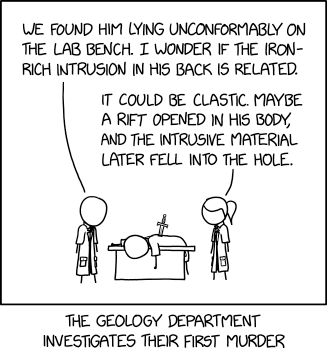#3112: Geology Murder
Permalink
Transcript
| This transcript is incomplete: Don't remove this notice too soon. If you can fix this issue, edit the page! |
[There's a lab bench with a dead Cueball lying on it, with a dagger sticking out of his back. Another Cueball is standing to the left of the table, Ponytail is standing to the right. They're each wearing lab coats and looking at the dead body.]
Cueball: We found him lying unconformably on the lab bench. I wonder if the iron-rich intrusion in his back is related.
Ponytail: It could be clastic. Maybe a rift opened in his body, and the intrusive material later fell into the hole.
[Caption below the comic:]
The Geology Department investigates their first murder
(Sourced from explainxkcd.com)
Title text:After determining that his body was full of pipes carrying iron-rich fluid, our current theory is that the dagger-shaped object precipitated within the wound.